Testing The World’s Best APUs: Desktop AMD Ryzen 4750G, 4650G and 4350G
by Dr. Ian Cutress on December 16, 2020 10:30 AM ESTCPU Benchmarks: Synthetic
All of our benchmark results can also be found in our benchmark engine, Bench.
Dwarf Fortress 0.44.12: Link
Emulating the ASCII interfaces of old, this title is a rather complex beast, which can generate environments subject to millennia of rule, famous faces, peasants, and key historical figures and events. The further you get into the game, depending on the size of the world, the slower it becomes as it has to simulate more famous people, more world events, and the natural way that humanoid creatures take over an environment. Like some kind of virus.
For our test we’re using DFMark. DFMark is a benchmark built by vorsgren on the Bay12Forums that gives two different modes built on DFHack: world generation and embark. These tests can be configured, but range anywhere from 3 minutes to several hours. After analyzing the test, we ended up going for three different world generation sizes:
- Small, a 65x65 world with 250 years, 10 civilizations and 4 megabeasts
- Medium, a 127x127 world with 550 years, 10 civilizations and 4 megabeasts
- Large, a 257x257 world with 550 years, 40 civilizations and 10 megabeasts
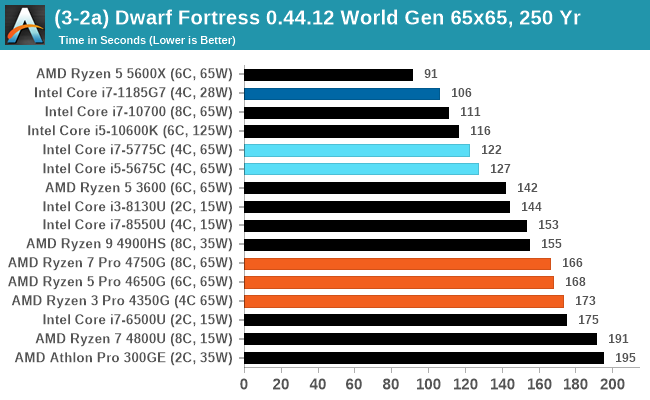
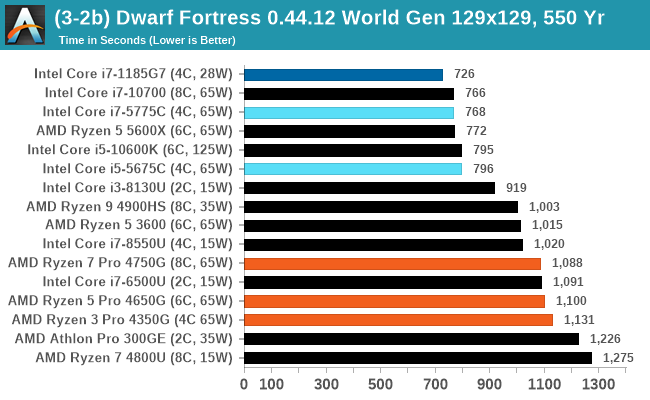
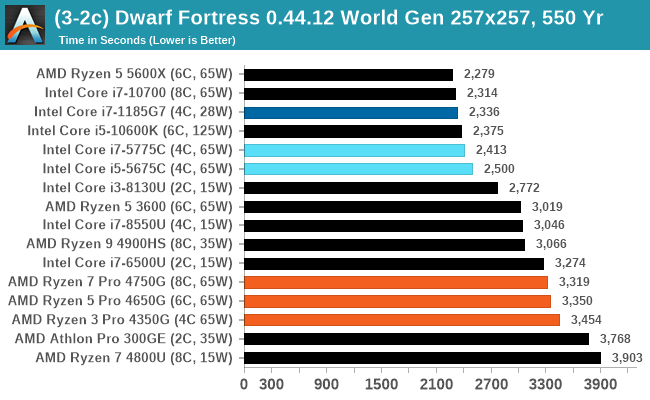
Dolphin v5.0 Emulation: Link
Many emulators are often bound by single thread CPU performance, and general reports tended to suggest that Haswell provided a significant boost to emulator performance. This benchmark runs a Wii program that ray traces a complex 3D scene inside the Dolphin Wii emulator. Performance on this benchmark is a good proxy of the speed of Dolphin CPU emulation, which is an intensive single core task using most aspects of a CPU. Results are given in seconds, where the Wii itself scores 1051 seconds.

3D Particle Movement v2.1: AVX2/AVX512
This is the latest version of this benchmark designed to simulate semi-optimized scientific algorithms taken directly from my doctorate thesis. This involves randomly moving particles in a 3D space using a set of algorithms that define random movement. For v2.1, we also have a fully optimized AVX2/AVX512 version, which uses intrinsics to get the best performance out of the software.
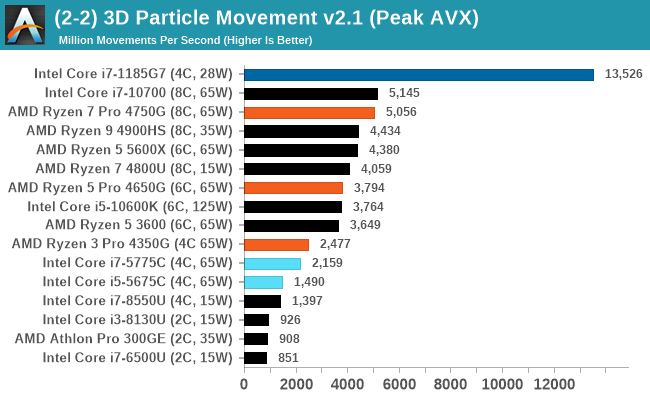
Tiger Lake wins here as it has an AVX512 unit.
y-Cruncher 0.78.9506: www.numberworld.org/y-cruncher
If you ask anyone what sort of computer holds the world record for calculating the most digits of pi, I can guarantee that a good portion of those answers might point to some colossus super computer built into a mountain by a super-villain. Fortunately nothing could be further from the truth – the computer with the record is a quad socket Ivy Bridge server with 300 TB of storage. The software that was run to get that was y-cruncher.
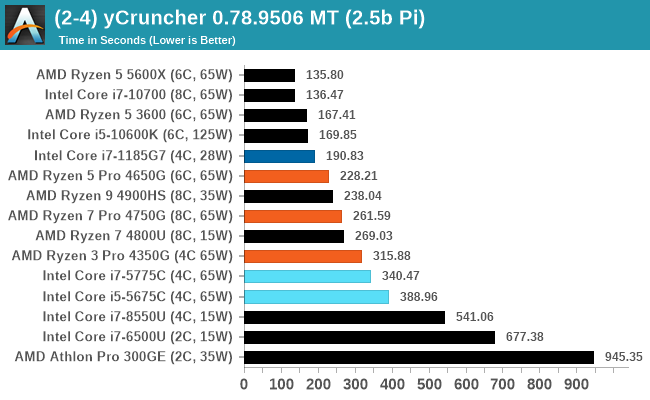
This is another AVX-512 test.
Linux OpenSSL Speed: SHA256
One of our readers reached out in early 2020 and stated that he was interested in looking at OpenSSL hashing rates in Linux. Luckily OpenSSL in Linux has a function called ‘speed’ that allows the user to determine how fast the system is for any given hashing algorithm, as well as signing and verifying messages.
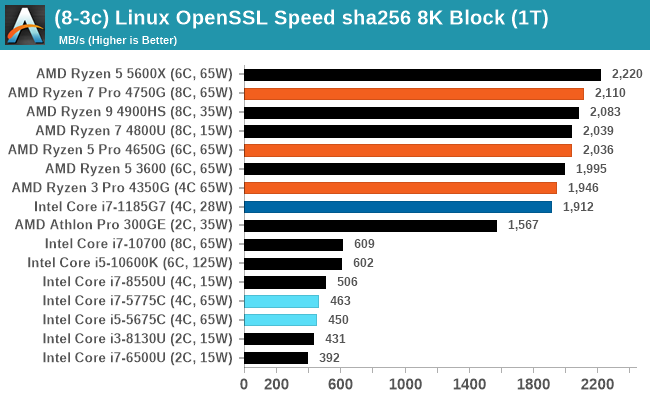
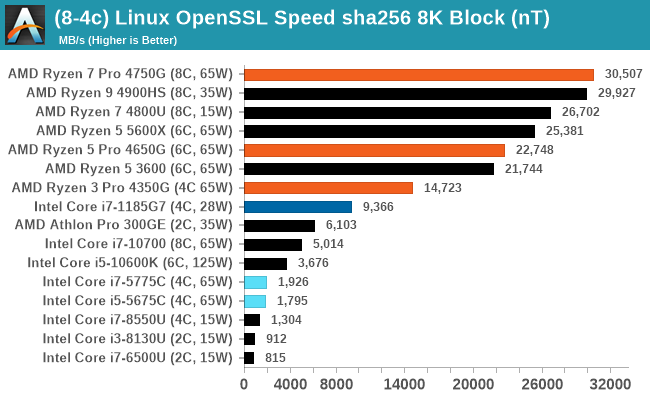










104 Comments
View All Comments
Fulljack - Thursday, December 17, 2020 - link
comparing x86 with ARM64 just won't be fair, as there's too many variable at play. but, comparing it as an Apple laptop with general x86 laptop e.g. MSI Prestige or Acer Swift would be fair, though.Frantisek - Sunday, December 20, 2020 - link
What is weird is that there is not single word about M1. Neither in Conclusion where autor go throught many architectures even consoles. But onmit hot new ball on playground. Seems like lack of communication among authors here.regsEx - Wednesday, December 23, 2020 - link
So as Intel non-F CPUs which are also APUs. Even 10900K is APU.29a - Wednesday, December 16, 2020 - link
I agree the data in this article is useless because no one would ever use these settings. Why not using settings that people would actually play at?0ldman79 - Thursday, December 17, 2020 - link
I tend to agree.It doesn't match up with the rest of the benches but when we're comparing it to GTX 950, GTX 1030, etc, 360P, no one plays that, 1080P max, no one can play that.
I either wind up playing at 720P max or 1080P medium on my laptop, which would be comparable.
Irata - Thursday, December 17, 2020 - link
Agree. Even having a 1080p minimum option would be useful, and perhaps the inclusion of more e-sports titles. Fortnite, CS Go and similar games should have pretty decent frame rates @ 1080p with reduced quality settings.MDD1963 - Friday, December 18, 2020 - link
Thank God we got *lots* of results of the APU's performance when paired with a discrete GPU, however! (This lets the uninformed overlook the fact that discrete graphics still blows chunks...) SHowing results below 720P is, frankly, utterly retarded...nunya112 - Saturday, December 19, 2020 - link
I think for a laptop integrated gpu 720p maxed out settingsAnd for a desktop APU 1080P medium should be a target for 125W desktop should be ok. as a 1080P GPU card would be 60W +
ET - Sunday, December 20, 2020 - link
Yeah, same comment. I'd have loved to see tests relevant to how people will want to play the games with such an iGPU.Also, would have been nice to see the comparisons to the 3400G and 2400G in the discrete GPU and CPU sections.
n13L5 - Wednesday, December 30, 2020 - link
Good point... 360p... what?